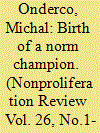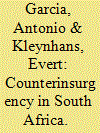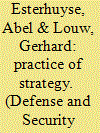|
|
|
Sort Order |
|
|
|
Items / Page
|
|
|
|
|
|
|
| Srl | Item |
| 1 |
ID:
166861


|
|
|
|
|
| Summary/Abstract |
In 1995, South Africa was in a special position. It was: a new party to the Treaty on the Non-Proliferation of Nuclear Weapons (NPT), the first country to voluntarily renounce nuclear weapons, led by a charismatic leader, and seen as a champion of disarmament principles. Yet South Africa’s new leaders were also interested in affirming their position within the Non-Aligned Movement, which was adamantly opposed to the NPT’s indefinite extension. Why, then, did South Africa decide to support the indefinite extension of the NPT in 1995? Existing scholarship has ascribed too much credit to pressure from the United States, overlooking domestic debates in South Africa and the bifurcation between professional diplomats and political elites. This article, building on new archival sources and in-depth oral-history interviews with major actors, demonstrates that South African diplomats opposed indefinite extension while South African policy elites allocated little attention to the topic until late in the game. The findings contribute to our understanding of South Africa’s norm entrepreneurship, as well as the politics of global nonproliferation.
|
|
|
|
|
|
|
|
|
|
|
|
|
|
|
|
| 2 |
ID:
177671


|
|
|
|
|
| Summary/Abstract |
The entry of the Union of South Africa into the First World War, as well as the subsequent invasion of German South West Africa (GSWA), served as a trigger to the Afrikaner Rebellion. In September 1914 the Union Defence Force (UDF) suffered a major reverse at the Battle of Sandfontein. However, in addition to the German threat, South Africa faced a second, more serious internal threat. The socio-economic realities of early-twentieth-century South Africa, felt most keenly among rural Afrikaners, magnified the rift between the competing interests of Afrikaner nationalists and the Union government loyal to the Crown. The Union’s entry into the war was a step too far for many Nationalist Afrikaners and ultimately precipitated the outbreak of the rebellion. As a result, the operational focus of the UDF shifted to the internal military threat posed by Afrikaner rebel forces. The Afrikaner Rebellion brought about the first counterinsurgency operation of the UDF within the borders of South Africa. By harnessing its operational and tactical mobility, and operating from the central position and along internal lines of communication, the UDF swiftly dealt with the rebel revolt. This article evaluates the counterinsurgency operations conducted by the UDF in suppressing the Afrikaner Rebellion.
|
|
|
|
|
|
|
|
|
|
|
|
|
|
|
|
| 3 |
ID:
160994


|
|
|
|
|
| Summary/Abstract |
The article concerns the strategy development processes of the South African Department of Defence in South Africa. It intends to identify the probable causes of the observed failure of the South African National Defence Force to develop appropriate departmental policy and military strategy. Military strategy comprises force development, force employment, force deployment and the coordination of these elements in pursuit of national, grand-strategic objectives. (See Dennis M. Drew and Donald M. Snow, Making Twenty-first Century Strategy: An Introduction to Modern National Security Processes and Problems Montgomery, AL: Air University Press, Maxwell Air Force Base, November 2006, 103). Of these four constructs, the article concerns itself only with the first two. The article analyses two complementary approaches to strategy formation: a resource-driven, inside-out model and an interests-driven, outside-in method. The article concludes that the Department is preoccupied with the inside-out method to the lasting detriment of the declared strategic intent of the defence policy.
|
|
|
|
|
|
|
|
|
|
|
|
|
|
|
|
|
|
|
|
|